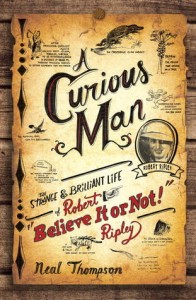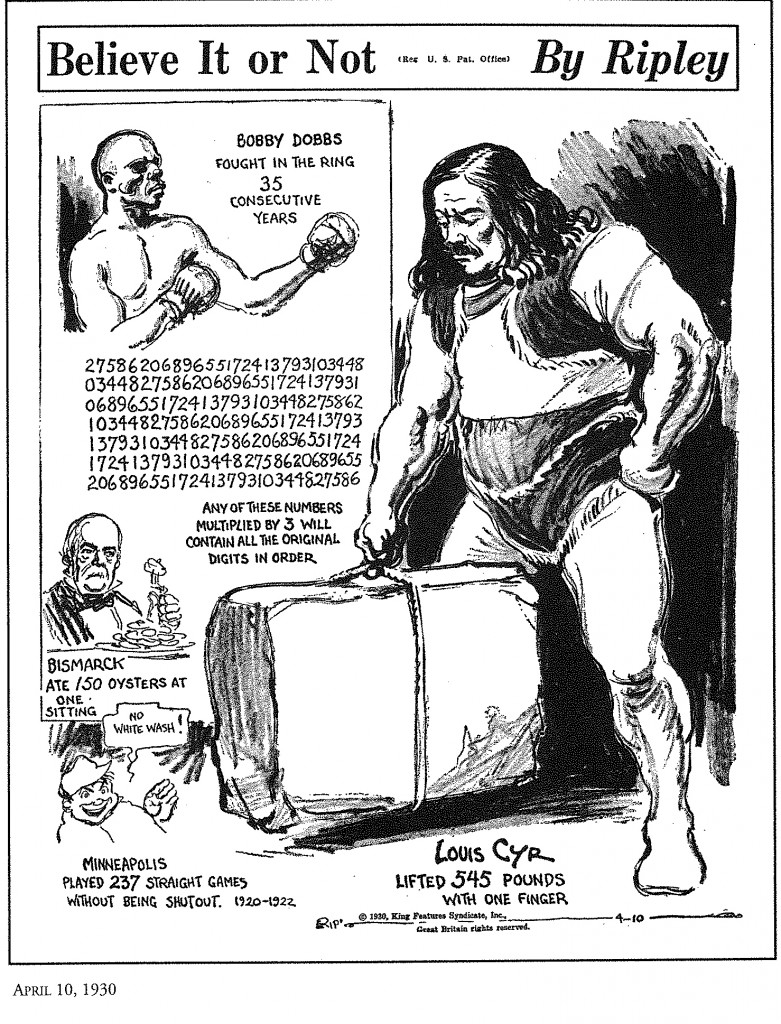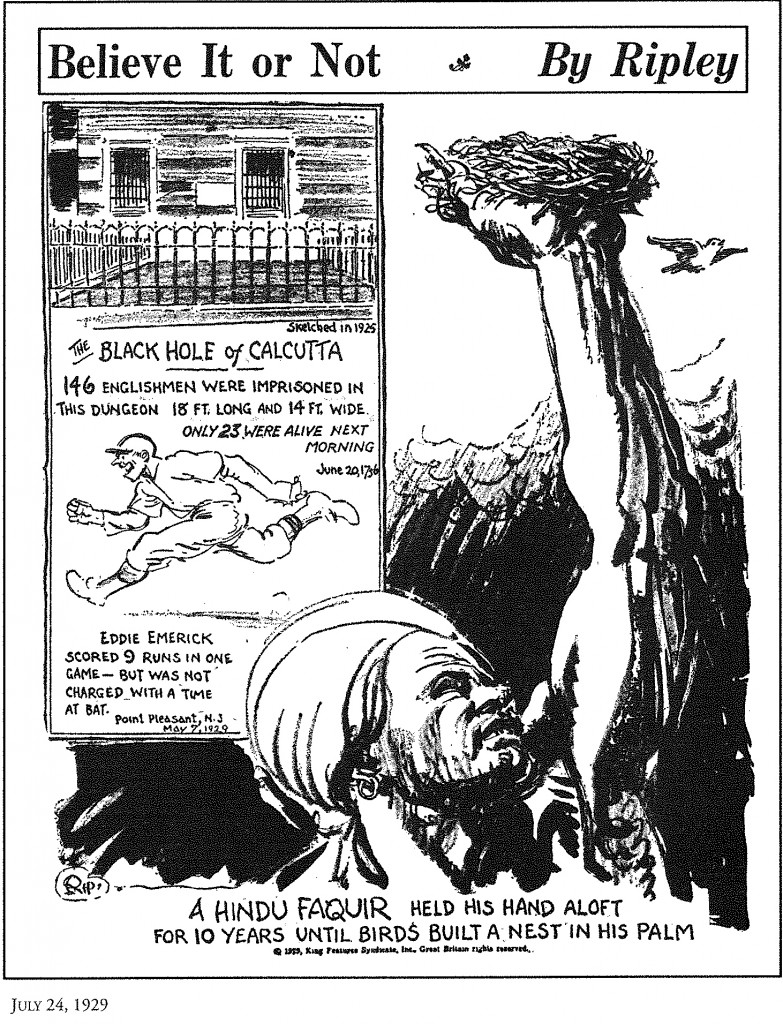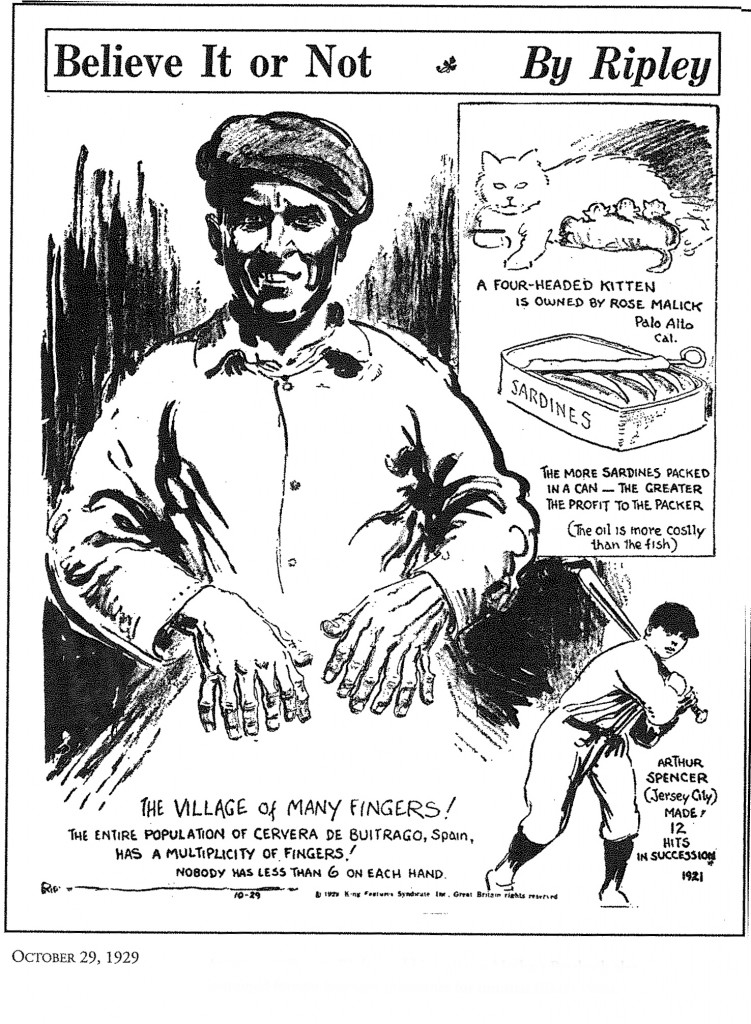
A Curious Man: The Strange & Brilliant Life of Robert “Believe it or Not” Ripley & Ripley’s Believe It or Not: The Original Cartoons That Started It All! 1929-1930
Did you know:
A Hindu Fakir held his hand aloft for ten years until birds built a nest in his palm;
Horses don’t pull—they push;
It rains fish every July in Yoro, Honduras;
Someone built a radio on the head of a pin;
Louis Cyr lifted 545 pounds with one finger;
Any whole number diminished by the sum of its digits will always be divisible by 9;
The entire population of Cervera de Buitrago, Spain has at least six fingers on each hand;
No matter how you arrange the digits of the number 123456789, the resulting number will always be divisible by 9;
A cartoonist named Robert Ripley noted in his November 3, 1929 Believe It or Not feature that the United States had no national anthem and that as a result of the outcry President Hoover signed a one-sentence bill on March 3, 1931 that made “The Star-Spangled Banner” America’s national anthem.[i]
Of course, you would know all of this and much more arcane stuff if you regularly read Ripley’s Believe It or Not as I did between the ages of 9 and 14 when every school kid I knew was Ripley-mad. We could not get enough of his books—collections of his daily newspaper cartoons plus new cartoons done in the Ripley style after Robert Ripley’s death in 1949—and we could not stop talking about the strange knowledge we gleaned from the odd world of the Ripley imagination, made up of equal parts intense research, freak show fascination, non-western exoticism, and pure hokum. He was frequently called a liar by irate readers who sometimes challenged his “facts,” (the public also supplied him with stuff for the cartoons as, at his height, he received more than 20,000 letters a week, a million letters a year). He enjoyed disbelief. 
As children, all of us thought that what made Believe It or Not so compulsively readable, so seductive, was the strange facts we learned. It was not until I was a bit older, a college student, that I discovered that this was not true, certainly not entirely so. One day, as an undergraduate long past his Ripley days, I was thumbing through a new edition of Believe It or Not that replaced Ripley’s drawings with the actual photographs upon which the drawings were based. I was thunderstruck to find that the photos were far less interesting to me than the verisimilitude of the drawings which I felt were more imaginative, more vivid, more creative, more humorous, simply more enjoyable and more joyful. The drawings were art; the photos were not. It occurred to me at that moment, nearly 40 years ago, that what truly captured my heart and mind as a kid about Believe It or Not was not just the facts (ma’am) but the drawings. I—all of the kids who were big Ripley fans—really loved the pictures. In one sense, for us, Believe It or Not was another comic book but not just another comic book. It was a stupendous comic about everything and nothing, absurd, profound, smart, and ridiculous simultaneously. Like an amusement park, Believe It or Not was a cheap thrill but it also brought together a community of seekers who sought their faith through the excess of the unusual. Believe It or Not played the reader for a sucker while also confirming the reader’s innocence and wonder about a world that did not conform to order or expectation, that seemed both whimsical and ferocious in producing Gods, monsters, and challenges to our assumptions about what is genuine. Biographer Neal Thompson in his A Curious Man informs the reader that a poll in 1940 disclosed that Ripley’s daily cartoon was the second most popular feature of American newspapers, beaten only by the front page. Robert Ripley was one of the great cartoonists in the history of American illustration. Perhaps what made his work so appealing was that he was an autodidact who, in his younger days, worked incessantly on his craft.
Believe It or Not played the reader for a sucker while also confirming the reader’s innocence and wonder about a world that did not conform to order or expectation, that seemed both whimsical and ferocious in producing Gods, monsters, and challenges to our assumptions about what is genuine.
Believe It or Not was authenticated by Ripley’s travels, which he publicized heavily as they were usually sponsored by whatever newspaper he happened to be working for or, later, by radio or television contract. He would send back columns and cartoons for the newspaper or tape shows on the road for his electronic audience. The public knew him as an intrepid sojourner, as mythical in his pursuit of the unexplored and strange corners of the globe as Marco Polo or Magellan. Ripley’s ambition was to visit every country in the world and to be the world’s most traveled person. He nearly achieved this as he traveled incessantly, spurred by both curiosity and restlessness, by adventure and anxiety, by the need for discovery and the affliction of discontent. What strikes the reader is how insouciant, utterly careless Ripley was as a traveler, almost impulsive: no bug spray, medications, sensible clothing, or prudence for him. Often dressed to the nines and sweating profusely in hot climates, he survived on alcohol (he was, not to put too fine a point on it, an alcoholic and always searching for the next new drink), guts, guile, and an insatiable craving for physical deformity and social deviance, sensuality, and sex. (On this last point, at the height of his fame in the 1930s and 1940s, when Ripley was one of the highest paid, if not the highest paid, cartoonist in the world, a millionaire, he kept a harem of women, mostly Chinese or “Oriental,” at his New York mansion.)
Ripley’s travels to non-white countries made him aware of race. According to Thompson, “Ripley sometimes felt self-conscious about the extreme whiteness of his skin, in contrast to the exotic darkness of the “natives.” He thought Bali inhabited by “lovable, brown-skinned people” who were “the most artistic on earth.” Thompson continues: “Ripley preferred his “natives” to be authentically native—barefoot and bare-breasted, living simply in their huts of grass.” Thompson also quotes Ripley as saying, “Missionaries are the curse of Africa, the same as they are the curse of the Islands of the South Seas. The black man of Africa in his savage state is a gentleman. Only when he starts to become civilized does he lose his character and become diseased, immoral, unhealthy, and criminal.” Ripley’s assessment here is worded in a racially inelegant way, Eurocentric and paternalistic, but the basic sentiment of how whites have corrupted the culture and underdeveloped the lives of African peoples would have found agreement with black nationalists, Pan Africanists, and Afrocentrists everywhere. He especially loved China, had several Chinese lovers, “imagined himself as the reincarnation of a Chinese war lord,” according to Thompson and wanted to return to this life as a Chinese man.
Perhaps the reason that Believe It or Not so appealed to the children of my generation was because, like Ripley, we were incredibly curious about the world, sought deviance in ways that were socially acceptable (freaks and oddities) while also being shocking, enlightening, and humanizing to us as scion of a liberal order, and because our minds, like Ripley’s, as one Ripley colleague put it, was “uncluttered by culture.” So, the Santa Rosa native with protruding teeth who became a sports cartoonist whose first cartoon entitled BION appeared on October 16, 1919, touched, not a nerve, but rather expressed a certain sort of public yearning, through his art. It has been supplanted, in part, by reality television which, in fact, imitates the Ripley radio, television, “odditorium” or “museum” shows. Nothing successfully imitated the cartoons which will outlive everything else. Ripley’s cartoons did more to help the odd get even than anything else in the world of the visuals that do not pretend to move.
